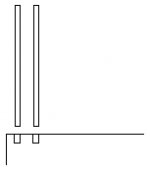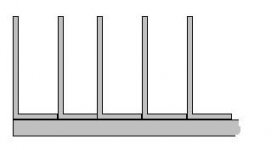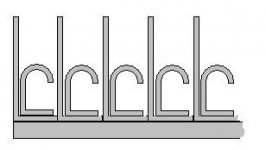What about building your own heatsinks?
I know there is a lot on the internet about building your own heatsinks, but what is your experience? Can it be done by the average DIY-er?
Is it possible to make high quality (passive), cheap, low Rth ( < 0.2) and good looking heatsinks?
I'm particular interested in practical experience from people who built such heatsinks themselves.
I know there is a lot on the internet about building your own heatsinks, but what is your experience? Can it be done by the average DIY-er?
Is it possible to make high quality (passive), cheap, low Rth ( < 0.2) and good looking heatsinks?
I'm particular interested in practical experience from people who built such heatsinks themselves.
DIY heatsinks: effort/visual appearance
Hi Trioth,
Since I will be in need of a lot of heatsink hardware soon, I am doing a little investigation here to see if it is feasable to construct my own.
What (estimated-) Rth did you achieve (power dissipation required) and what further dimensions did it need for this?
One of my reservations is also if you can bond the individual metal parts good enough together to get a good overall heat distribution efficiency in the heatsink itself.
I am the average DIY-er I was referring to in my 1st post, so I don't have all the fancy equipment and expert skills to do the metal work.
Visual appearance is also important to me, so I want to make sure that the result of a particular method of constructing your own heatsinks is both good looking and -working.
The amount of effort you have to/want to put in is of course related to the amount of money you can save.
And the amount of money you can save is also dependent on how many heatsinks you will be making, the benefits of "mass production". ;-)
Hi Trioth,
Since I will be in need of a lot of heatsink hardware soon, I am doing a little investigation here to see if it is feasable to construct my own.
What (estimated-) Rth did you achieve (power dissipation required) and what further dimensions did it need for this?
One of my reservations is also if you can bond the individual metal parts good enough together to get a good overall heat distribution efficiency in the heatsink itself.
I am the average DIY-er I was referring to in my 1st post, so I don't have all the fancy equipment and expert skills to do the metal work.
Visual appearance is also important to me, so I want to make sure that the result of a particular method of constructing your own heatsinks is both good looking and -working.
The amount of effort you have to/want to put in is of course related to the amount of money you can save.
And the amount of money you can save is also dependent on how many heatsinks you will be making, the benefits of "mass production". ;-)
Heat sinks are very easy to make?
That kind of answer from you, "The one and Only", makes me curious about what would be your "preferred method".......... ;-)
Heat sinks are very easy to make. Really.
That kind of answer from you, "The one and Only", makes me curious about what would be your "preferred method".......... ;-)
Then why do they cost so much?Nelson Pass said:Heat sinks are very easy to make. Really.
Sorry I couldnt resist.... LOL
Heat Sink Cost.
They cost so much because of tooling, short runs and because they simple can charge what they want. Used is good if you can find them. Making your own can be done well. There are decided advantages. You can but 12mm ( 1/2" ) plate and bond or bolt fins to it. You can get more sophisticated and cut a bunch of channels and make up a bonded fin heat sink. There are ways to do it. It requires the right adhesive. Peferable a thermally conductive epoxy or filled isocyanarate (speeled it wrong again).
and some patience. Could can and should be done. Cheaper than a bargain surplus?? Nope. Better??? Depends on the plate thickness, fin thicknes, spacing and depth. But done right a bonded fin heat sink is one of the most efficient means of dissipating allot of heat.
Food for thought in BIG BITES
Mark
They cost so much because of tooling, short runs and because they simple can charge what they want. Used is good if you can find them. Making your own can be done well. There are decided advantages. You can but 12mm ( 1/2" ) plate and bond or bolt fins to it. You can get more sophisticated and cut a bunch of channels and make up a bonded fin heat sink. There are ways to do it. It requires the right adhesive. Peferable a thermally conductive epoxy or filled isocyanarate (speeled it wrong again).
and some patience. Could can and should be done. Cheaper than a bargain surplus?? Nope. Better??? Depends on the plate thickness, fin thicknes, spacing and depth. But done right a bonded fin heat sink is one of the most efficient means of dissipating allot of heat.
Food for thought in BIG BITES
Mark
Gleued heatsinks
Hi Mark,
Could you please elaborate a little bit on the method of gleuing plates and fins together etc. I did not completely understand your post. (What do you mean with channels here?)
It seems to me it could be an interesting method for DIY.
Are good thermal conductive adhesives easy to get?
What about black anodisation and glueing?
Hi Mark,
Could you please elaborate a little bit on the method of gleuing plates and fins together etc. I did not completely understand your post. (What do you mean with channels here?)
It seems to me it could be an interesting method for DIY.
Are good thermal conductive adhesives easy to get?
What about black anodisation and glueing?
Nelson Pass said:Heat sinks are very easy to make. Really.
a milling machine is a wonderful investment. Aluminum cuts like butter. (my kids gave me the small Grizzly model last year. still haven't outfitted it for CNC, however).
for good heatsinks +DIY , the surplus market is where to go --
How about this????
My first advice is look up bonded fin heat sinks. Get some ideas of your own. To create a thick base plate is a given. The thickness of the radiating fins is more indepth. I don't pretent to be a thermal engineer but there are some great guides on the net from the many heat sink manufactuers. Common sense will tell you that thinner metal will cool off more quickly. The placement of the fins can be shown in the manufactured examples you might want to search out. Here is a bit of a scetch to get the idea across.
The grooves could be cut on even a table saw. As for their thickness it depends on the width of the fins. The other possibility is to bond thin aluminum sheet metal bent up in a suitable pattern. This option is really only economically feasable if you know where to get srcap aluminum and have at least ruimentary mechanical skills. As for the glues I don't know where in europe. Most heatsink manufactuers have a type. And the big adhesive manufactuers will also have something (loctite, hernon,etc) This is not a run out and do it type project. It will take preparation. But the gee wiz factor is there. The possibilty to dissipate heat is there. So why not???
Mark
My first advice is look up bonded fin heat sinks. Get some ideas of your own. To create a thick base plate is a given. The thickness of the radiating fins is more indepth. I don't pretent to be a thermal engineer but there are some great guides on the net from the many heat sink manufactuers. Common sense will tell you that thinner metal will cool off more quickly. The placement of the fins can be shown in the manufactured examples you might want to search out. Here is a bit of a scetch to get the idea across.
The grooves could be cut on even a table saw. As for their thickness it depends on the width of the fins. The other possibility is to bond thin aluminum sheet metal bent up in a suitable pattern. This option is really only economically feasable if you know where to get srcap aluminum and have at least ruimentary mechanical skills. As for the glues I don't know where in europe. Most heatsink manufactuers have a type. And the big adhesive manufactuers will also have something (loctite, hernon,etc) This is not a run out and do it type project. It will take preparation. But the gee wiz factor is there. The possibilty to dissipate heat is there. So why not???
Mark
Attachments
This is my proposal.
Add aluminium L sheets to aluminium plate using pop rivets.
Add some "heat conduct grease" between those L and plate parts.
Those L parts can be different sizes if you want.
Of course you can add some kind grid or grill to cover that odd looking heatsink
Add aluminium L sheets to aluminium plate using pop rivets.
Add some "heat conduct grease" between those L and plate parts.
Those L parts can be different sizes if you want.
Of course you can add some kind grid or grill to cover that odd looking heatsink

Attachments
Re: Gleued heatsinks
Computer part dealers should have silicon (pi) or silver grease if you mean that!
Also somekind heat conduct glue is possible get from those PC shops too.
byteboy said:
Are good thermal conductive adhesives easy to get?
Computer part dealers should have silicon (pi) or silver grease if you mean that!
Also somekind heat conduct glue is possible get from those PC shops too.
Don't want to spoil the fun but...
If I would go to my local hardwarestore (which isnt expensive, much cheaper than large diy mals) and would order an alu. plate 10 mm thick of 200*300 mm (lets say) and 10 200 mm long L profiles (30*60, 4 mm thick) I doubt it would be much cheaper than then the 300*200 Seifert heatsinks that I use now ($ 60, which btw has a 16 mm base)).
Maybe if you do all the sawing and cutting yourself.
And then it still has to be anodized..
If I would go to my local hardwarestore (which isnt expensive, much cheaper than large diy mals) and would order an alu. plate 10 mm thick of 200*300 mm (lets say) and 10 200 mm long L profiles (30*60, 4 mm thick) I doubt it would be much cheaper than then the 300*200 Seifert heatsinks that I use now ($ 60, which btw has a 16 mm base)).
Maybe if you do all the sawing and cutting yourself.
And then it still has to be anodized..
Somebody mentioned machining of heatsinks....that one is easy to take the fun out of....aluminium bar will set you back at least 6usd per kilogram for a reasonable quality....and even if you got the aluminium for free, its "no can do" cause the material would work(bend and stretch) because of uneven material removal...it would be virtually impossible to make a flat side.
To make a heatsink of aluminium profiles (or even better copper) is the way to go if you want conventional looking heatsinks. Just use heat conductive epoxy (can be bought at RS, Farnell and so on)
A different solution thats a little easier and just as good (if not better) is to cut sheets of metal and use metal blocks as spacers in between...then just bolt the whole thing together....now thats a 10 thumbs solution
Magura
To make a heatsink of aluminium profiles (or even better copper) is the way to go if you want conventional looking heatsinks. Just use heat conductive epoxy (can be bought at RS, Farnell and so on)
A different solution thats a little easier and just as good (if not better) is to cut sheets of metal and use metal blocks as spacers in between...then just bolt the whole thing together....now thats a 10 thumbs solution
Magura
How about buying a sheet of Aluminium and then folding it ?
Folded fins heatsinks are supposed to be very good.
A thin (1-2 mm) sheet of Aluminium cant be that expensive). Folding it can't be that hard. When the folding is done glue it to a thicker copper/aluminium sheet.
What do you think ? I'm really thinking of trying this...
/Tobias
Folded fins heatsinks are supposed to be very good.
A thin (1-2 mm) sheet of Aluminium cant be that expensive). Folding it can't be that hard. When the folding is done glue it to a thicker copper/aluminium sheet.
What do you think ? I'm really thinking of trying this...
/Tobias
- Status
- This old topic is closed. If you want to reopen this topic, contact a moderator using the "Report Post" button.
- Home
- Amplifiers
- Pass Labs
- DIY heatsinks


